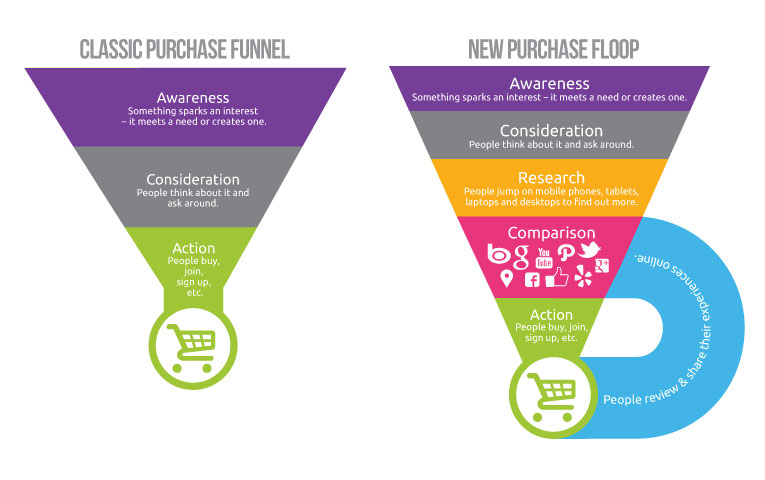Shopping Has Changed. Has Your Marketing?
Tuesday, August 30, 2016
by Carol Glover
Marketing
Shopping Has Changed. Has Your Marketing?
We don’t shop like we used to. Yet we “shop” for everything. Whether we’re looking for shoes, a doctor, a great burger or where to get an MBA, we dig for information like never before. What does it mean for marketers? Well, forget the classic purchasing funnel.
Classic Purchase Funnel
- Awareness
We see something that sparks our interest – it meets a need or creates a need. - Consideration
We think about it, ask others. - Action
We buy, join, sign up, etc.
Here’s what that process looks like today.
New Purchase Floop
- Awareness
Something we see sparks our interest – it meets a need or creates a need. - Consideration
We think about it and ask around, but a lot of it happens online. - Research
We jump on our mobile phones, tablets, laptops and desktops to find more information. - Comparison
We search Google and Bing to compare similar products and prices. We search YouTube for demonstrations and testimonials. We search Pinterest and Instagram for pics and go to Yelp for reviews. We check websites and apps to see how green or socially responsible a company is. We poll our Facebook and Twitter communities for their opinions. We look for check-ins and likes, pluses and snaps. - Action
We buy, join, sign up, etc., but that’s not the end of the story. - Review
We go online or jump on our social networks to review and share our experience.
So, while “consideration” used to involve conversations with co-workers like, “You have a Ford truck. Do you like it? How’s the gas mileage?” now we research purchases like we’re writing a college dissertation. Even little things like batteries. Before we go to the store we Google “batteries” on our iPads or Kindles looking for reviews and coupons. We even stand in the battery aisle with our mobile phones pulling up batteries.com, shopping sites or other stores to compare prices. If claims seem too good to be true, we ask our Facebook friends. And when we finally buy the darn batteries, we write reviews and tell our friends just how great (or lamely) they worked.
That means if you’re a battery brand it’s not enough to be on TV, show up in shopping flyers and have a big display at the store; you have to be where people are actually “shopping” – and that’s online. (Google has coined this shopping phenomenon: Micro-Moments.)

Just how prevalent is it? Take a look.
- 82 percent of customers say they consult their phones about a purchase they are about to make in store1.
- 30 percent of consumers have changed their mind in the shopping aisle as a result of information gathered on their smartphone2.
- 67 percent say that either reading or writing social media reviews influences their online purchase decisions3.
Now what?
It’s time to take hard look at how your customers are “shopping.” A little research into their customer journeys will help you know where to meet them along the way – and how to keep them moving through the Floop to you.
- “5 Ways Consumers Connect to Stores With Mobile Shopping,” Google Think, Feb. 2016
- “Social Trends Report,” Bazaarvoice, 2016
- “Total Retail Survey,” PWC, 2016
Tags: PR & Social Media, Retail, Web & Digital